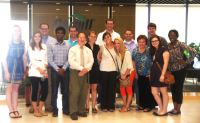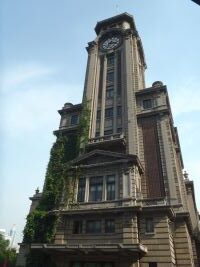We’re in Xi’an, a city of 8 million, but one, as I’m fond of writing, that was the capital of China for over 1000 years (thirteen dynasties, our guide reminds us; can you name more than 3? Qin, Han, and Tang?), but most recently 1000 years ago. It’s a reminder that China was once THE place to come for fashion, political ideas, culture, and what passed for “electronics” in those days. It was one terminus of the Silk Road that connected Europe and Asia, and brought the sophistication of the East to the backsliding West.
The journey here began with our last day in Shanghai, with a great site visit  to a former student who is the General Manager of Cargill China. I hope that Confucius’ saying, “It is a great pleasure to welcome guests who come from afar” applies to him, because I was certainly glad to visit with him. Omar Sadeque graduated IWU in 1992, got an MBA from Baylor, and went to work for Cargill. Though I’ve followed his career, it’s been mostly from a distance. The last time I visited him, it was May of 1997 or so, and he had just been sent to China, where, reasonably fresh from the MBA program, he’d been given around $30 million and told to “start a chicken feed plant.” I remember being impressed by his responsibilities, and by his expat life style, which included car/driver/apartment/cook and maid. He successfully established that plant, and has spent most of his career in the East—in Indonesia and Thailand, among other locations, helping grow the 12% of Cargill’s business that is in Asia. I’ve heard good things about him from his coworkers in Malaysia, Viet Nam, and Singapore, where I have visited Cargill operations courtesy of the University of Wisconsin Faculty Development Trips.
to a former student who is the General Manager of Cargill China. I hope that Confucius’ saying, “It is a great pleasure to welcome guests who come from afar” applies to him, because I was certainly glad to visit with him. Omar Sadeque graduated IWU in 1992, got an MBA from Baylor, and went to work for Cargill. Though I’ve followed his career, it’s been mostly from a distance. The last time I visited him, it was May of 1997 or so, and he had just been sent to China, where, reasonably fresh from the MBA program, he’d been given around $30 million and told to “start a chicken feed plant.” I remember being impressed by his responsibilities, and by his expat life style, which included car/driver/apartment/cook and maid. He successfully established that plant, and has spent most of his career in the East—in Indonesia and Thailand, among other locations, helping grow the 12% of Cargill’s business that is in Asia. I’ve heard good things about him from his coworkers in Malaysia, Viet Nam, and Singapore, where I have visited Cargill operations courtesy of the University of Wisconsin Faculty Development Trips.

His current assignment is a major one—to build a chicken processing plant in Anhui province that will eventually employ 4500 people, and perhaps supply chicken, as Cargill does elsewhere, to McDonalds and KFC. The company kind of flies under the radar; although it’s a $120 billion corporation, and would rank in the top 15 of the Fortune 500, it’s still family held, and in a business far less glamorous than Infosys, which has comparable revenues. Its motto is nourishing people and nourishing ideas, and I’ve been impressed with what I know about its social responsibility. When we were in Viet Nam, for example, the plant manager took us to a school that Cargill and its suppliers built and maintain for youth in an area where the government cannot afford to build schools.
Omar’s task was not only to do the right thing, as he put it, but to do it in the right way. He helped the company negotiate the purchase of land rights (only the government owns land in China) from 1500 farmers, promising them not just a fair price, but an annuity, and moving them elsewhere. A similar operation in India would probably cause (as it has) a farm protest, and indeed, similar displacements in China (the Yangtze Gorges project displaced over 1.5 million people) have provoked riots and unrest. But not many agreements contain the annuity. It is an impressive company, and I’m certain that a number of students present will consider applying to the Minneapolis-based corporation.
Before our 21 hour train ride to Xi’an, we had an afternoon free to browse in Shanghai. The bus took us to a market that houses mostly knockoff goods. It used to be a big open air market for fake North Face, Rolex, etc., but the intellectual property negotiations have made the knockoff market become less obvious in China.
For me, the building was a short walk from People’s Park, and there were a few sites there that I would much rather have seen—and did. People’s Park occupied what had once been the racetrack in Shanghai, and I have postcards of it from the 1920s and 1930s. The Chinese government  converted the clock tower and grandstand into a Museum of Modern Art, and it’s story, as well as the planned growth of Shanghai, were related in a nearby museum; on visiting it, I was able to check it off my bucket list.
converted the clock tower and grandstand into a Museum of Modern Art, and it’s story, as well as the planned growth of Shanghai, were related in a nearby museum; on visiting it, I was able to check it off my bucket list.
The 21 hour train ride (I almost typed “strain ride”) was kind of a shock to the students. On the Hong Kong-Shanghai train, being an international train, there was a baggage car; hence, the four-bed compartment (the so-called soft sleeper) was fairly comfortable with our day packs and us. On the Xi’an train, we had to take our luggage into the compartment, and find a way to store it and us together. I think our students understood why Chinese travel light. After the visit to the knockoff market, several students had to buy additional suitcases!
Well, we are here in Xi’an which means Western Peace. It was also called Chang an, which means long peace. I’d hoped to write more, but I’ll save it for after our tour tomorrow (when we visit the terra cotta warriors) or Saturday, where we tour before another train ride.